2024.07.18

Such a huge change when we put our mind to it!
Mitsubishi Estate's "Creating an office that makes you want to come to work".

According to the Ministry of Land, Infrastructure, Transport and Tourism`s FY2023 Telework
Population Survey,16.1% of corporate employees and public servants in Japan teleworked in
the previous year, a year-on-year decrease of 2.7 points. Further analysis showed that,
during the COVID-19 pandemic, those who teleworked between 1 and 4 days had increased, and
hybrid work — the combination of going to work and teleworking — had become more
common.
In these circumstances, many organizations are concerned about whether their existing
offices are fit for purpose. Typical concerns are whether it is OK to operate the same type
of office as before the pandemic, how big it should be now that fewer employees are
commuting to the office, and what kind of space should be created to ensure that maximum use
is made of the time they actually spend there.
Mitsubishi Estate, a developer and operator of office buildings in Japan’s major business
areas, had relocated its headquarters in 2018, before the pandemic. After a major renovation
in 2023, the company is conducting guided tours of its headquarters to introduce its clients
and other stake holders to how the new, idealized workplaces will be implemented.
Hikari Ota is a manager in the Facility Management Consultancy Office, Office Leasing and
Tenant Relations Department 1. As an expert on the relationship between the work style and
the workplace and as a member of the renovation project team, she explains the concept as
follows.
“Now that teleworking is well established, it is possible to work anywhere, and the office
has changed from being a ‘place to work ’ to a ‘place to communicate’ where people build
relationships and create the corporate culture. Office design is now much more than just
simply providing the number of seats required for the total number of employees. The first
step in planning a new office is to think about the company's ideal image and how each
company would like to operate and grow using its workplace. We want to help each company to
create offices that fit their needs and holding the tours is part of that.”
Making “Borderless” a reality! An office that make you want to come to work
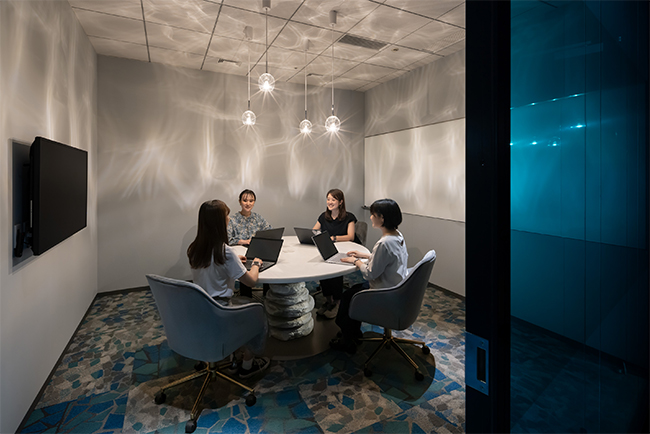
▲While it is possible to view the interior from outside, the blue glass prevents the detail from being seen. This creates an other-worldly atmosphere.

▲The snack booth offering ices and pastries. A space for colleagues to spontaneously chat with each other, with with topical books nearby.
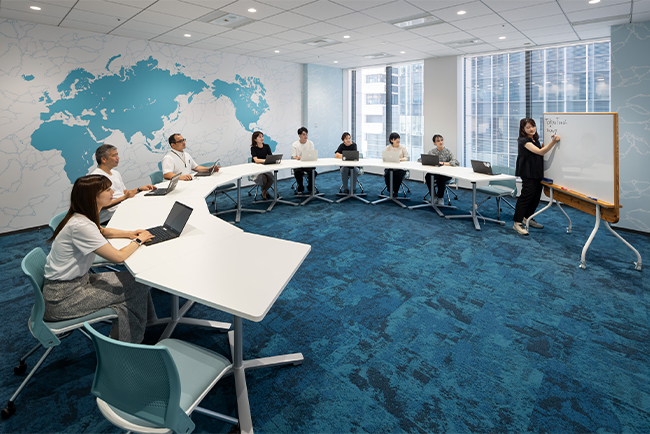
▲In meeting rooms designed for idea generation, desks and chairs can be arranged at will to avoid role fixation, which encourages lively debate.
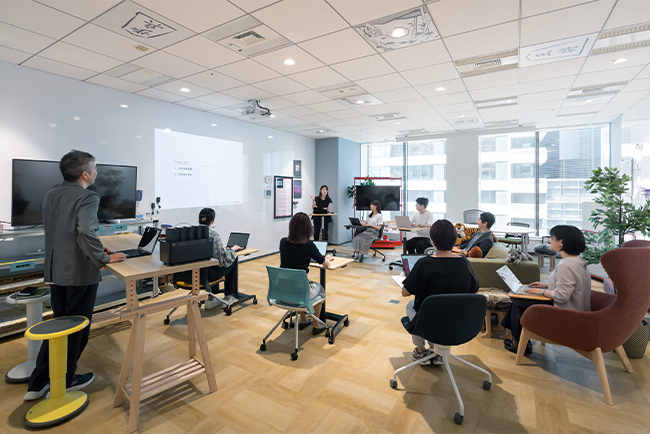
▲Walls become giant white boards! An atmosphere where everyone can freely express their opinions to support dynamic meetings just made for face-to-face interaction.
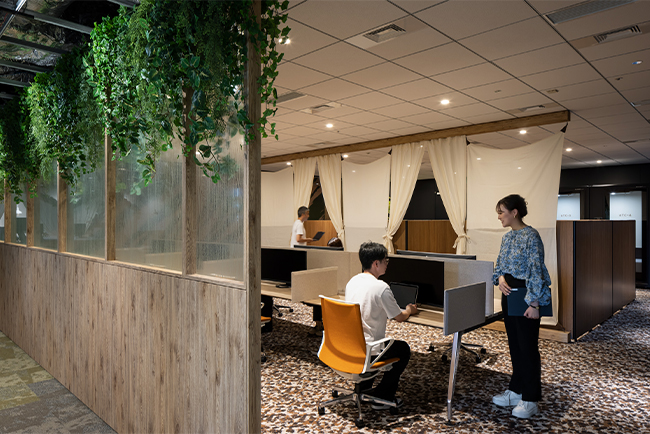
▲The renovated office features many individual rooms and booths, allowing employees to concentrate as much as they need to nurture and refine ideas originating from communication and meetings.
From relocation, via the pandemic, to a greater emphasis on communication
Before relocating to the present headquarters, Mitsubishi Estate had an office arrangement
that was typical at that time. This was characterized by walls separating each section, and
seating arrangements in each room that placed the managers at the front, distant from the
young employees at the back. The seniority system prevailed, divisions opened up between the
sections, and a silo mentality was inevitable.
The relocation concept, "Borderless! x Socializing!," was developed with the goal of
breaking free from an unchanging workstyle. The goal was to create a space that eliminated
the psychological boundaries between employees, allowing for more fluid communication and
collaboration. With 70% of the stored documents eliminated, the new office featured an open
work space with group address zones. Furthermore, there was also an expansion of
communication opportunities, such as introduction of cafeterias. This was highly appreciated
by the employees.
These steps alone were sufficient to transform the office into an environment that was
considerably more conducive to work.However, Mitsubishi Estate did not stop there.The
company continually conducted employee surveys, one of which found that a small relaxation
room which had been a focus of attention when relocating in 2018, had since lost its
popularity due to the rise of teleworking and flexitime working during the pandemic. It also
became evident that the utilization rates for certain meeting rooms had declined and that
they were no longer being effectively utilized.
The social circumstances have changed, and so have the working styles. We need offices that
are suitable for the new working styles. This is why we decided to renovate the common areas
extensively.
“Many employees expressed their desire to dedicate time to face-to-face communication and
discussions during the office workday.. We thereforeprovided comprehensive support for
communication, and explored methods to enhance productivity. The introduction of new meeting
rooms equipped with portable furniture and adjustable layouts enabled participants to engage
in joint meetings with minimal restriction based on their position within the company. This
initiative brought colleagues closer together, with the usage rate of the new rooms nearly
doubling that of the former general-purpose meeting rooms. When considering the
post-pandemic office, I was able to appreciate the absolute need to support
communication.”
A mini lending library was also established at the light refreshment booth with a mechanism
created to allow employees to come and go and chat. To promote communication and
collaboration, employees were encouraged to interact with colleagues from different sections
in dedicated workspaces outside designated group address zones. In addition, the number of
booths for individual concentration and customized meeting rooms for online meetings was
increased to provide employees with dedicated spaces to nurture and refine ideas generated
through communication.
“After the renovation, we received a lot of employee feedback including the following
comments: ‘It led to new ideas more easily,’ ‘Flexible opinions and ideas could come to the
surface,’‘I could carefully deepen my thoughts at the focus booths,’ and ‘Leaving my own
section’s zone when I was stuck for ideas was an effective way to change my mood.’”
Essential to human capital management, office design forms part of operating strategy
There is a growing trend of companies adopting "human capital management" initiatives. This
approach views human resources as a form of capital and aims to maximize the return on this
investment, which can lead to mid to long-term increases in company value. These initiatives
focus on key questions such as how to retain suitable staff and reduce turnover rates. As
part of this, it is essential to assess the optimal design of office spaces.
“In my opinion, corporate worth can be enhanced not only through the introduction flexible
working hours and remort working systems, but also by creating an environment where
employess can demonstrate their abilities. To achieve this, an increasing number of
companies are involving not only their general affairs departments but also HR and business
planning teams in the development of their office strategy.”
It is important to note that changing your office is likely to be expensive. While this is
something that should be considered carefully, Hikari Ota recommends taking a mid to
long-term viewpoint.
“Through the relocation and renovation of our headquater, we have realized that , office
creation is not a `cost` but an `investment for the future`. We believe that by investing in
our offices, we have been able to grow in the right direction as a company in various
aspects, such as responding to diverse work styles and changing the mindset of our
employees. Putting the office into perspective is also a way of rewarding our employees and
is part of our management strategy. We would be happy if you would consider developing an
office as an opportunity to take the next step towards growth. Please contact us for a tour
or to discuss your needs!
【Contact】
Mitsubishi Estate Co., Ltd.
Office Leasing and Tenant Relations Department 1
☎︎ 03・3287・5310
https://office.mec.co.jp/
INTERVIEWEES
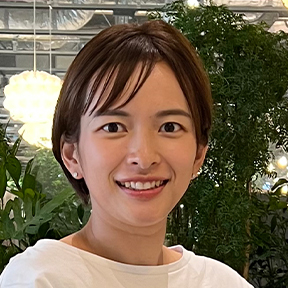
HIKARI OTA
Manager, Facility Management Consultancy Office,
Office Leasing and Tenant Relations Department 1
Mitsubishi Estate Co., Ltd.
Otemachi Park Building, 1-1, Otemachi 1-chome, Chiyoda-ku, Tokyo
Mitsubishi Estate Co., Ltd. is a comprehensive real estate company, established in
1937.
With its mission, “Contribute to society through Machizukuri (urban development)”,
the company engages in the development, leasing, and management of office buildings
and commercial properties, typified by the cluster of buildings in Marunouchi, Tokyo
the development, leasing, and management of hotels and logistics facilities, the
development and sale of residential properties, design supervision, real estate
brokerage services, international businesses, and investment management business.
With its office business, the company expanding its business in major cities in
Japan, will respond to people’s shifting values, working style, and needs as the
tiems change.
